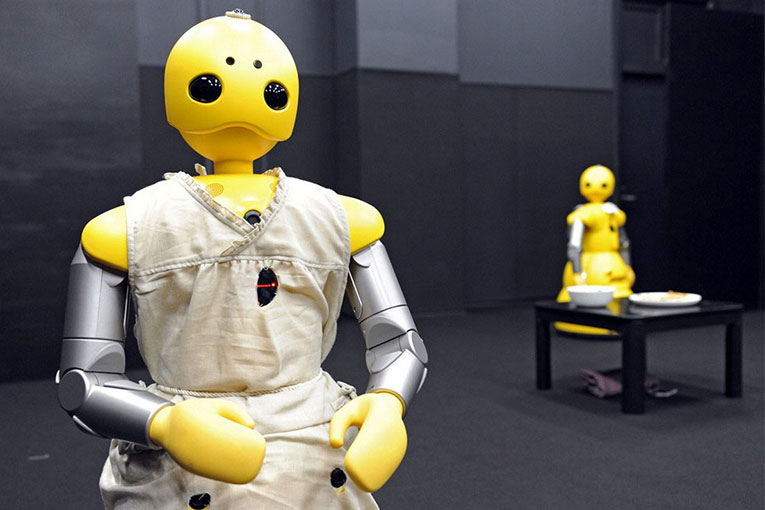Social Robots
A meeting point between science and fiction
DOI: 10.7203/metode.82.3546

|
Industrial robots and androids in science fiction were worlds apart until recently, but now begin to merge with the rapid development of social robotics. Given the growing need for labour in the healthcare and service sectors, robots are being designed to interact with disabled or elderly people , or to take the place of receptionists or shop assistants in shopping malls, or even to act as support teachers or nannies. Within this context, efforts have grown to encourage mutual inspiration between techno-science and humanities. Ethical issues such as the influence of robotic nannies on child psyche previously within the realms of literary works, are now being discussed in scientific forums. Keywords: social robots, artificial intelligence, science fiction, Asimov, roboethics. |
||
|
Until recently, robotics research and robots in science fiction had taken separate paths which seldom crossed. Industrial robots in production lines had little to do with the androids inhabiting Asimov or Philip K. Dick’s stories. In recent years, the remarkable advances in disciplines such as mechanics, electronics and computer technology, along with the need to open new markets, have led to the development of humanoid robots. These new robots are no longer confined to factories, but designed to interact with people in urban contexts, in care-provision and in the service sector in general. They are generically called social robots. This shift in robotics from the industrial context to the social field has aroused scientific researchers’ interest in the literary speculation on science fiction, and there have been various initiatives seeking for synergies between these two ambits. |
«This shift in robotics from the industrial context to the social field has aroused scientific researchers’ interest in the literary speculation on science fiction» | |
 The uncanny valley effect describes a person’s emotional response to an artificial being based on its anthropomorphism. The android Saya (left), developed at the University of Tokyo, arouses less positive reactions than the robot from the movie Wall-e (right). / Tokyo University (left). Disney Pixar (right) |
||
|
SCIENCE AND LITERATURE: MUTUAL INSPIRATION The latest edition of the most prestigious congress on Robotics, the IEEE Conference on Robotics and Automation – ICRA’13 – included a forum open to the general public, for the first time ever, which took place after the technical sessions, to discuss the topic «robotics meets the humanities». The speakers were four university professors – two from engineering and two from literature –, a filmmaker, a performer who uses robotic genius in his stage performances, a representative from the European Commission and a robotics researcher and writer. One of the issues discussed, which is key to social acceptance of robots, is the uncanny valley effect, which has its origins in Greek philosophy and has been widely discussed in psychoanalytical literature. This effect describes a person’s emotional response to an artificial being – a robot in this case – and it so happens that the more anthropomorphic the robot, the more positive and empathetic the response, until it reaches a point when excessive similarity causes sudden revulsion. Cooperation between those working in technology and in humanities is also essential to try to predict how robotics will influence the future development of society. There are significant methodological difficulties involved in making this prediction (Ballesté and Torras, 2013). Unforeseen uses always crop up for any kind of technology developed (Ihde, 2002), as in the case of cell phones, initially intended for commercial interactions. It is clear that technological development cannot be studied outside its socio-cultural context (Berger and Luckmann, 1966). The limitations of language to describe the future should also be kept in mind; quoting Heidegger it is «through technique that we perceive the sea as navigable». Given the difficulty in predicting how a technological society will evolve, a reasonable choice is to imagine different possible future scenarios and encourage debate on the pros and cons of each one to try to guide techno-scientific research in the most desirable direction. That is what the European Commission has tried to do through Futurium, a platform where anyone can contribute their vision of the future. In search of greater professionalism, other initiatives have turned to science-fiction writers to outline the most varied and consistent future scenarios. In 2012 the Center for Science and the Imagination was set up at Arizona State University. The idea came from a thought-provoking speech by Neal Stephenson (2011), given in the presence of the university president, in which the writer stated that today’s scientists had lost the ability to think and do «great things», like those that had previously inspired the Apollo space programme or the microprocessor. The president responded that perhaps it was the science-fiction writers who were at fault because they were failing to evoke an ambitious future that would inspire scientists to make them into a reality. As a result, the centre now houses several research groups that bring together researchers in science and humanities to devise and endeavour to achieve ambitious goals that shape the future. One of the projects run by the Center for Science and the Imagination is the continuation of an initiative launched by the company Intel, The Tomorrow Project, in which they asked four science-fiction writers to write separate accounts of the future use of its products in photonics, robotics, telematics and smart sensors. The book with the four accounts is open access (Rushkoff et al., 2012), and a second volume appeared recently in which solutions are proposed to the greatest challenges facing humanity today, through visual arts and writing, all as a result of the work carried out at this centre. In the field of robotics, the encounter between science and fiction occurred well before the aforementioned projects were conceived. For more than a decade fictional robots and those developed in research laboratories have shared The Robot Hall of Fame an initiative that Carnegie-Mellon University started in 2003 to draw attention to the increasing contribution of robots to society. Every two years, by popular vote open to everyone, four robots are admitted to the hall, whether real or fictitious. Among the honoured robots are: Wall-e from the Disney movie of the same name; C-3PO and R2-D2 from Star Wars; Robby from Forbidden Planet; PackBot the robot, who intervened after the Fukushima disaster and the quadruped Big Dog. |
 Carniege Mellon University Carniege Mellon UniversityPackBot robot, employed after the Fukushima disaster. |
|
 Robots in The Robot Hall of Fame, from top to bottom: C-3PO and R2-D2 from Star Wars, Robby from the Forbidden Planet and BigDog quadruped./ Lucas film (left). Mètode (centre). Boston Dynamics (right) |
||
|
EVOLUTION OF ROBOTICS IN FICTION AND IN SCIENCE In making a brief historical outline, we could say that fascination with bodies and artificial minds is as old as the human ability to imagine, but the idea of building them gained strength with the philosophical ideas of the Enlightenment (Bueno Gómez-Tejedor and Peirano, 2009). After automatons such as Vaucanson’s duck or Von Kempelen’s chess player came alive in the eighteenth century, androids sprung up in the works of the nineteenth century’s speculative fiction, such as Sand Man, by E. T. A. Hoffmann, or Frankenstein by Mary Shelley, an appearance that stirred up mixed emotions. The word robot first appeared in 1920 in the play RUR: Rossum’s Universal Robots, by the playwright Karel Capek. In Czech, robota means «work», and the play is about the RUR company, which, to facilitate the task of working men, produces androids that pass off as humans. This vision of substituting workers with robots in production chains dominated robotics research throughout the second half of the twentieth century and led to successive generations of industrial robots. These were essentially programmable articulated arms performing repetitive tasks, with increasingly more sensory capacities and better mechanical performance. Meanwhile, the literary field was still exploring the intimate and moral aspects of humanoid robots that went far beyond those industrial arms, not only in form but also in their field of action, mainly the domestic and social spheres. In the early twenty-first century, the growing need for labour in the healthcare and service sectors – partly motivated by the aging of population in the more developed countries – has led to an increase in the potential fields where robots can be exploited. In the coming years we will see robots attending to the disabled and elderly, performing household tasks, acting as support teachers, assistants in shopping malls, receptionists, guides at trade-fairs and museums, and even as nannies and playmates. This shift from industrial robotics to social robotics presents a series of new challenges for techno-scientific research and, at the same time, highlights cognitive skills required for interaction between people and robots. This shift also fosters the convergence of this field with humanities and, in particular, with psychology, ethics and literature. Before going into the aforementioned aspects, here is a brief sketch of the challenges posed by the so-called social robots: they must be easy to programme by non-experts, intrinsically safe, able to perceive and manipulate deformable objects, tolerant to imprecise perceptions and actions and above all, be endowed with a great capacity for learning and adaptability to non-predefined and dynamic environments. Several research groups are conducting projects in this area at universities and research centres. For example, at the CSIC-UPC Instituto de Robótica e Informática Industrial (Institute of Robotics and Industrial Informatics) two European projects have been completed: Paco-Plus and Urus, aimed at developing robots to work as assistant chefs and as urban guides, respectively. Other related projects are Garnics and IntellAct, which deal with the perception and manipulation capacities needed by a gardener robot and a robot conceived to take on maintenance tasks. |
«The word robot first appeared in 1920 in the play ‘RUR’, Rossum’s Universal Robots, by the playwright Karel Capek. In Czech, ‘robota’ means “work”» |
|
 Some studies highlight the need to analyse ethical issues before developing technologies such as nanny robots for the mass market. Sixty years ago, Isaac Asimov foresaw some of these ethical issues in his story Robbie. / Wakamaru |
||
|
THE ETHICS OF SOCIAL ROBOTICS: THE CASE OF ROBOT NANNIES Clearly social robots pose a wider range of ethical issues than their industrial predecessors, and this is the main reason for the aforementioned growth in interest in humanities shown by the scientific community working in robotics. The urge is not only to anticipate possible scenarios, but also to identify the moral problems that they entail and shed light on the suitability of the different future scenarios from an ethical perspective. Several roboethics initiatives and projects are underway in an attempt to answer questions arising in contexts as diverse as the military, educational and legal fields. Given the breadth of the subject and scope of this article, I will keep to the role played by literature in anticipating learning scenarios and the development of interpersonal relationships. In 2010 the journal Interaction Studies brought out a special issue discussing the influence that the use of nanny robots might have on the psychological development of children. The introductory article in the volume (Sharkey and Sharkey, 2010) defends the need to analyse ethical issues before developing this kind of technology for the mass market, and draws attention to a number of tricky issues that should be addressed. It is fascinating that, sixty years ago, in his famous story Robbie (Asimov, 1950), Isaac Asimov predicted some of the issues raised in the aforementioned article. For example, to what extent robots should protect children and spare them danger, as this restricts their freedom and may be detrimental to becoming mature and autonomous. Another coincidence is the comparison between a pet and a robot dog. To show the arguments for and against mechanical pets, Asimov presents a couple in which the mother is in favour of the dog but anti-robot sentiment turns her against it, while the rational father is convinced of the benefits of technology. In his tale Nanny (Dick, 1955), Philip K. Dick also anticipates a pair of issues under current debate. One of them is the desirability of mounting a camera on a robot nanny, which lets parents monitor their children’s outdoor explorations from the comfort of their living-room. The other relates to the difficulty to categorize the robot in the inanimate-animate binaries distinction, Dick demonstrates this difficulty by using the effective linguistic trick of referring to the robot as an it or a she depending on whether the scene is described by the omniscient narrator or from the child’s point of view. There are many related stories, such as I Sing the Body Electric by Ray Bradbury (1969), in which a child is reluctant to accept an electric grandmother as a substitute for his dead mother, until the Grandma shows her immortality. This is a clear advantage of robot nannies: they do not come and go like their human counterparts; and the other thing is that they do not tell lies, so parents know exactly whose hands they leave their beloved children in. I gave my opinion on these ethical issues in the abovementioned special issue (Torras, 2010), so here I will keep to the role that literature can play in this debate. If robots are called on to form part of the future educational community, it is important that society as a whole should form an opinion on what type robots they would accept. Perhaps half way through last century it was premature to start a public debate on robotic nannies, but it has now become most appropriate, or even necessary, given the rapid development of social robots. New and up-to-date fiction stories akin to those of Asimov, Dick and Bradbury can help promote fruitful discussion in the fields of education, prospective technology, and also – as mentioned at the beginning – research. In an endeavour to contribute in this respect, I have given many lectures to non-specialist audiences on technological advances in social robotics and the likely implications for future generations. My perception is that interest in science and technology is still very limited and robots are seen as harmless toys above all. That encouraged me to have a go at fiction, and in the novel La mutación sentimental (The sentimental mutation) (Torras, 2008) I imagined a future society where personal robots have modified thinking, relationships and feelings, improving them or making them worse depending on each person’s point of view. I am still amazed by the great attention it has received from the media and the general public. One can speculate the reasons why, but the truth is that my ideas have reached many more people through fiction than through science. I would like to round off with some words that the prestigious journal Nature included in an editorial of the volume entitled Many Worlds, commemorating the fiftieth anniversary of the hypothesis of Hugh Everett III about parallel universes, and containing articles that deal with this topic from both quantum mechanics and science fiction. It reads: «Serious science fiction takes science seriously. [..] Science fiction does not tell us what the future will bring, but at its best it helps us to understand what the future will feel like, and how we might feel when one way of looking at the world is overtaken by another». Visionary literature has always taken science seriously and has tried to project into the future. It seems that science is also starting to take this literature seriously and find inspiration therein. This meeting could be extremely productive and is very good news, opening up interesting perspectives for the coming years. |
||
References
Asimov, I., 1950. I, Robot. Gnome Press. New York.
Ballesté, F. and C. Torras, 2013. «Effects of Human-Machine Integration on the Construction of Identity». In Luppicini, R. (ed.). Handbook of Research on Technoself: Identity in a Technological Society. IGI Global. Hershey, EUA. DOI: <10.4018/978-1-4666-2211-1.ch030>.
Berger, P. and T. Luckmann, 1966. The Social Construction of Reality: A Treatise in the Sociology of Knowledge. Anchor Books. New York.
Bradbury, R., 1969. I Sing the Body Electric. Knopf Publishing. New York.
Bueno Gómez-Tejedor, S. and M. Peirano (eds.), 2009. El rival de Prometeo. Vidas de autómatas ilustres. Impedimenta. Madrid.
Dick, Ph. K., 1955. «Nanny». Startling Stories, 33(1): 50-61.
Ihde, D., 2002. Bodies in Technology. University of Minnesota Press. Minneapolis.
Nature, 2007. «Many Worlds». Nature, 448(7149): 1-104.
Rushkoff, D.; Hammond, R.; Thomas, S. and H. Markus, 2012. The Tomorrow Project. Bestselling Authors Describe Daily Life in the Future. Intel. Santa Clara.
Sharkey, N. and A. Sharkey, 2010. «The Crying Shame of Robot Nannies». Interaction Studies, 11(2): 161-190. DOI: <10.1075/is.11.2.01sha>.
Stephenson, N., 2011. «Innovation Starvation». Wired, 27 d'octubre. Available at: <http://www.wired.com/2011/10/stephenson-innovation-starvation>.
Torras, C., 2008. La mutació sentimental. Pagès Editors. Lérida.
Torras, C., 2010. «Robbie, the Pioneer Robot Nanny: Science Fiction Helps Develop Ethical Social Opinion». Interaction Studies, 11(2):269-273. DOI: <10.1075/is.11.2.15tor>.





